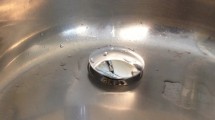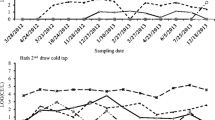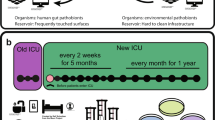Abstract
Planctomycetes have been isolated from various hydric environments. These fastidious bacteria are overlooked by routine 16S rRNA gene-based PCR detection in hospital laboratories, and their presence has not been documented in the health-care environment. Using a specific culture protocol, we recently isolated a new, non-filterable Planctomycetes species, Gemmata massiliana, from one hospital water network. The goal of the study was to monitor the presence of G. massiliana in two hospital water networks. We developed a G. massiliana-specific real-time PCR system and monitored the presence of the Planctomycetes for 12 months in two hospital water networks, in filtered water collected at the intensive care unit and in non-filtered water collected from dental chairs, tanks, and usage points. Four of 180 (2.2 %) filtered water samples tested positive versus 23 of 204 (11.3 %) non-filtered points (p < 0.05), including 18 of 128 (14.1 %) dental chairs, 3 of 51 (5.9 %) usage points, and two of 25 (8 %) tank specimens. There was no significant difference in the prevalence of G. massiliana between the two hospitals (p > 0.05). However, this organism was detected significantly more frequently during April and September than the 10 other months. Because G. massiliana is deeply entrenched in the hospitalized patient’s environment, evaluating this organism as a new opportunistic, health-care-associated pathogen is warranted.


Similar content being viewed by others
References
Anaissie EJ, Penzak SR, Dignani MC (2002) The hospital water supply as a source of nosocomial infections: a plea for action. Arch Intern Med 162:1483–1492
Berger P, Papazian L, Drancourt M, La Scola B, Auffray JP, Raoult D (2006) Ameba-associated microorganisms and diagnosis of nosocomial pneumonia. Emerg Infect Dis 12:248–255
Astagneau P, Desplaces N, Vincent V et al (2001) Mycobacterium xenopi spinal infections after discovertebral surgery: investigation and screening of a large outbreak. Lancet 358:747–751
Emmerson AM (2001) Emerging waterborne infections in health-care settings. Emerg Infect Dis 7:272–276
Exner M, Kramer A, Lajoie L, Gebel J, Engelhart S, Hartemann P (2005) Prevention and control of health care-associated waterborne infections in health care facilities. Am J Infect Control 33(5 Suppl 1):S26–S40
Baghal AF, Nikaeen M, Mirhendi H (2013) Rapid monitoring of Pseudomonas aeruginosa in hospital water systems: a key priority in prevention of nosocomial infection. FEMS Microbiol Lett 343:77–81
Fuerst JA, Sagulenko E (2011) Beyond the bacterium: planctomycetes challenge our concepts of microbial structure and function. Nat Rev Microbiol 9:403–413
Schlesner H (1994) The development of media suitable for the microorganisms morphologically resembling Planctomyces spp., Pirellula spp., and other Planctomycetales from various aquatic habitats using dilute media. Syst Appl Microbiol 17:135–145
Blackwood CB, Oaks A, Buyer JS (2005) Phylum- and class-specific PCR primers for general microbial community analysis. Appl Environ Microbiol 71:6193–6198
Sambe B, Armougom F, Raoult D, Drancourt M (2013) Molecular diversity of the Planctomycetes in the human gut microbiota in France and Senegal. APMIS 121:1082–1090
Drancourt M, Prebet T, Aghnatios R et al (2014) Planctomycetes DNA in febrile aplastic patients with leukemia, rash, diarrhea, and micronodular pneumonia. J Clin Microbiol 52:3453–3455
Acknowledgments
The authors would like to thank Agnes Delaby for her help with sampling.
Conflict of interest
None declared.
Funding
This study was funded by URMITE UMR CNRS 7278.
Author information
Authors and Affiliations
Corresponding author
Electronic supplementary material
Below is the link to the electronic supplementary material.
Rights and permissions
About this article
Cite this article
Aghnatios, R., Drancourt, M. Colonization of Hospital Water Networks by Gemmata massiliana, a New Planctomycetes Bacterium. Curr Microbiol 71, 317–320 (2015). https://doi.org/10.1007/s00284-015-0845-3
Received:
Accepted:
Published:
Issue Date:
DOI: https://doi.org/10.1007/s00284-015-0845-3




